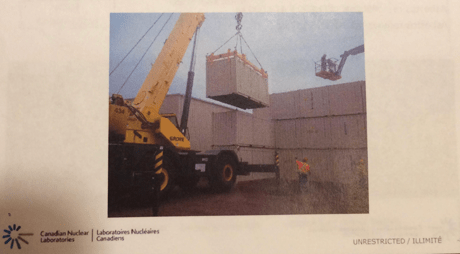November 5, 2020
See also: High level radioactive waste imports to Chalk River from Manitoba and Quebec will likely begin in 2025
CNL’s Integrated Waste Strategy (version 0) (obtained through ATIP in December 2017, 64 pages, contains many redactions)
CNL’s Integrated Waste Strategy (Version 1) (revised version, 37 pages) publicly available on CNL’s website)
The CNL Integrated Waste Strategy describes many types of radioactive wastes owned by the federal government in nuclear facilities in Manitoba, Ontario and Quebec. The document lays out a plan to consolidate as much of these wastes as possible at the Chalk River Laboratories site beside the Ottawa River upstream of Ottawa, Gatineau and Montreal for permanent disposal in a highly-controversial, yet-to-be-licensed giant radioactive waste mound.
Ottawa Valley residents are alarmed by this strategy to bring all of Canada’s federal nuclear waste to Chalk River. The site already has much radioactive waste in less than optimum storage conditions; wastes are leaking and contaminating the Ottawa River. See Chalk River’s Toxic Legacy by Ian McLeod in the Ottawa Citizen, December 16, 2011.
Radioactive waste shipments are already underway from other federal nuclear facilities in Canada. There are risks involved in transportation as described in our recent fact sheet “Transport of Radioactive Waste on Canadian Roads- a growing public risk”. Premature transportation of wastes before long-term management facilities are planned, evaluated, and licensed will result in double-transport and double-handling, creating additional unnecessary risks to workers and the public.
There are no approved disposal facilities at the CRL site; shipping containers full of wastes are presently being piled up at a Waste Management Area H as shown in the photograph below. The metal shipping containers are susceptible to corrosion and are exposed to precipitation in the current location.

The Chalk River Laboratories is not a good site for long-term storage of radioactive waste mainly because it is seismically active and adjacent to the Ottawa River which serves as a source of drinking water for millions of Canadians including citizens of Ottawa-Gatineau and many other communities. The site is also tornado prone.
[…] private sector consortium running Canadian Nuclear Laboratories plans to consolidate all the rest of the federal wastes in the Ottawa Valley and is already shipping radioactive wastes […]
LikeLike
[…] L’importation de déchets radioactifs dans la vallée de l’Outaouais à partir d’autres sites fédéraux (pour être placés dans l’installation) est un grand signal d’alarme pour les groupes de citoyens et les Premières nations. Ils disent que le site de Chalk River ne convient pas au stockage à long terme de déchets nucléaires. Selon une déclaration conjointe de la Nation Anishinabek et du Caucus iroquois, « Les rivières et les lacs sont le sang et les poumons de la Terre-Mère. Lorsque nous contaminons nos cours d’eau, nous empoisonnons la vie elle-même. C’est pourquoi les déchets radioactifs ne doivent pas être stockés à long terme à côté des grands plans d’eau. » […]
LikeLike
[…] The import of radioactive waste into the Ottawa Valley from other federal sites to be placed in the facility is a big red flag for citizens’ groups and First Nations.They say the Chalk River site is not suitable for long term storage of nuclear waste. According to a Joint Declaration from the Anishinabek Nation and Iroquois Caucus, “Rivers and lakes are the blood and the lungs of Mother Earth. When we contaminate our waterways, we are poisoning life itself. That is why radioactive waste must not be stored beside major water bodies for the long-term.” […]
LikeLike
[…] is importing commercial and federal nuclear wastes to Chalk River for disposal in the NSDF. These shipments are happening despite a specific […]
LikeLike
[…] dump proponent is importing commercial and federal nuclear wastes to Chalk River for disposal in the NSDF. These shipments are happening despite a specific request […]
LikeLike
[…] is important to note that the consortium continues to import commercial and federal nuclear wastes to Chalk River for placement in the NSDF. These shipments are happening despite […]
LikeLike
[…] que le consortium continue d’importer des déchets nucléaires commerciaux et fédéraux à Chalk River pour les placer dans l’IGDPS. Ces transferts ont lieu malgré […]
LikeLike
[…] Des déchets radioactifs commerciaux et provenant d’autres sites du gouvernement fédéral y seront […]
LikeLike
[…] See also CNL’s Integrated Waste Strategy alarms downstream residents […]
LikeLike